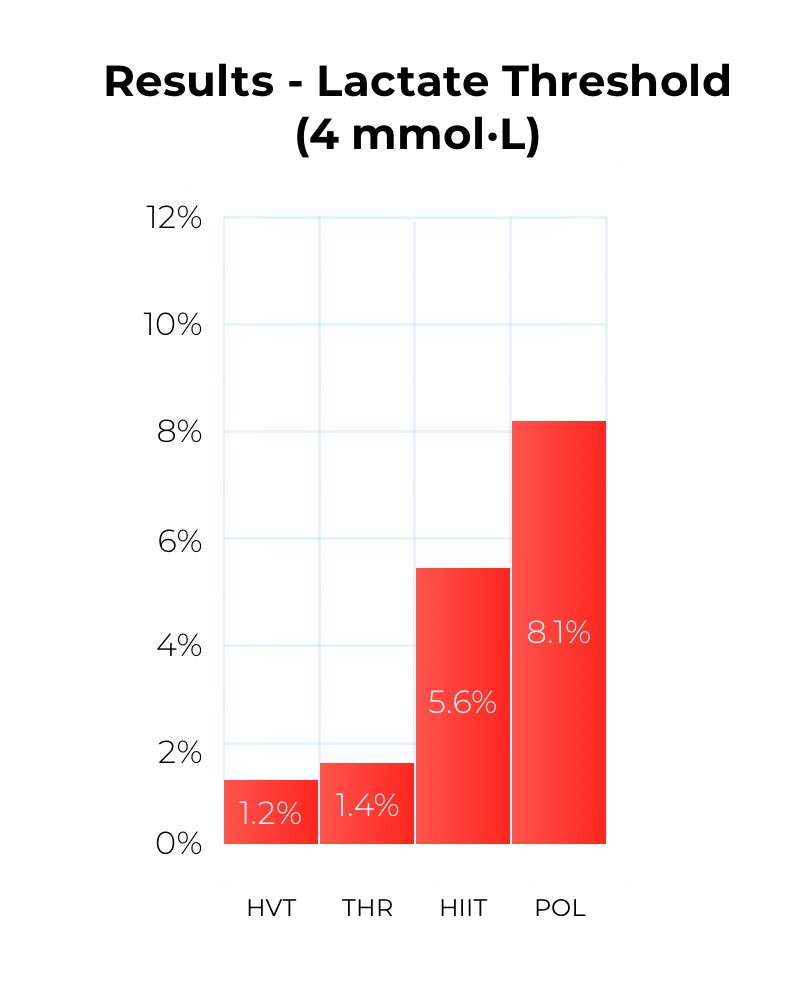Can You Increase Your FTP with Polarized Training?
What is the fastest way to improve your Functional Threshold Power?
What is the best way to improve your VO2 max?
Today I want to research what training can bring you the most benefits!
What is your pick? Let me know in the comments.
- (POL) Polarized Training
- (HIIT) Training
- (THR) Threshold Training
- (HVT) High Value Training
Testing Group
48 healthy competitive endurance athletes who participated in cross-country skiing national team (8), running (21), triathlon (4) and cycling (15) (age: 31 ± 6 years, body mass: 73.8 ± 9 kg, height: 180 ± 8 cm). All participants were well-trained with VO2 Max 62.6 ± 7.1 mL·min−1·kg−1 (range: 52–75 mL·min−1·kg−1) athletes, accustomed to a workload of more than five sessions per week (10–20 h/week) and had frequently been involved in endurance competitions for at least 8–20 years. Retrospective analysis of training protocols over 6 months prior to the study revealed that none of the participants had regularly executed HIIT. All had followed an HVT training protocol with a maximum of two THR training sessions per week.
All athletes were randomly picked to specific training protocols: HIIT, HVT, THR or POL. The study received approval from the University of Salzburg Austria Ethics Committee and was conducted in accordance with the Declaration of Helsinki.
The intervention lasted 9 weeks plus 2 days of pre- and post-testing. All participants were instructed not to change their diet throughout the training period and to maintain strength training, if it was part of their training program. Participants’ nutritional intake was not standardized or controlled during the study, but for the 3 h prior to all testing in which food intake was not permitted. The training intensity was controlled by HR based on the baseline incremental test: LOW (HR at blood lactate value <2 mmol·L−1); LT (HR corresponding to a blood lactate of 3–5 mmol·L−1); HIGH (>90% HRpeak)]. The HR was measured during each training session and athletes documented training mode, exercise duration, and intensity in a diary. As control and for detailed analysis, HR for all training sessions was stored digitally and analyzed retrospectively.*1
Training Protocols
LOW, low training intensity (<2 mmol·L−1); LT, training intensity around the lactate threshold (3–5 mmol·L−1); FL, fartlek; HIIT, high intensity interval training (>90% HRpeak); R, recovery day.
1. High Value Training Plan
Blocks: 3 x 3
2 weeks of training load: 6 training sessions with three 90 min LOW sessions, two 150–240 min LOW sessions and one 60 min LT session using different types of interval training (e.g., 5 × 7 min with 2 min recovery, 3 × 15 min with 3 min recovery)
1 week recovery: 3 training sessions with two 90 min LOW sessions and one 150–180 min LOW session.
2. Threshold Training Plan
Blocks: 3 x 3 weeks
2 weeks of training load: 6 sessions: 2 x 60 min with intervals at LT (5 x 6 min and 2 min recovery in the first block, 6 × 7 min in the second block and 6 × 8 min in the last block), one 90 min LT session with longer intervals (3 × 15 min with 3 min active recovery in the first block and 3 × 20 min for the remaining two blocks), one 75 min session with varying changes in intensity (“fartlek”) (intensities resulting in a blood lactate of 1.5–5 mmol·L−1) and two 90 min LOW sessions.
1 week recovery: one 60 min LOW session and two 60 min LT interval sessions (5 × 6 min with 2 min of active recovery).

3. HIIT Training Plan
Blocks: 2 x 16 days of intervals, plus adaptation week and recovery week.
Adaptation week: 2 60 min HIIT sessions, three 90 min LOW sessions, one 120 min LOW session and 1 day of recovery.
16 days of intervals: 12 HIIT sessions within 15 days, integrating four blocks of three HIIT sessions for three consecutive days followed by 1 day of recovery.
Recovery week: 4 LOW sessions of 90 min and 3 days without any training
All of the HIIT sessions included a 20 min warm-up at 75% of HRpeak, 4 × 4 min at 90–95% of HRpeak with 3 min active recovery and a 15 min cool-down at 75% HRpeak
4. Polarized Training Plan
Blocks: 3 x 3 weeks
2 weeks of training load: 6 sessions with two 60 min HIIT sessions, two 150–240 min long duration LOW sessions, which included six to eight maximal sprints of 5 s separated by at least 20 min, and two 90 min LOW sessions.
1 week recovery: 1 60 min HIIT session, one 120–180 min LOW session and one 90 min LOW session.

Conclusion
Polarized Training is a mix of high-value low-intensity training and HIIT training, with a correct balance that type of training can bring you the best overall benefits in terms of increasing your Threshold Power, VO2 Max, and Aerobic Threshold.
Remember to always adjust your training plan to your needs, but it is definitely worth it, to try Polarized Training. Find help with our Cycling Guide.












